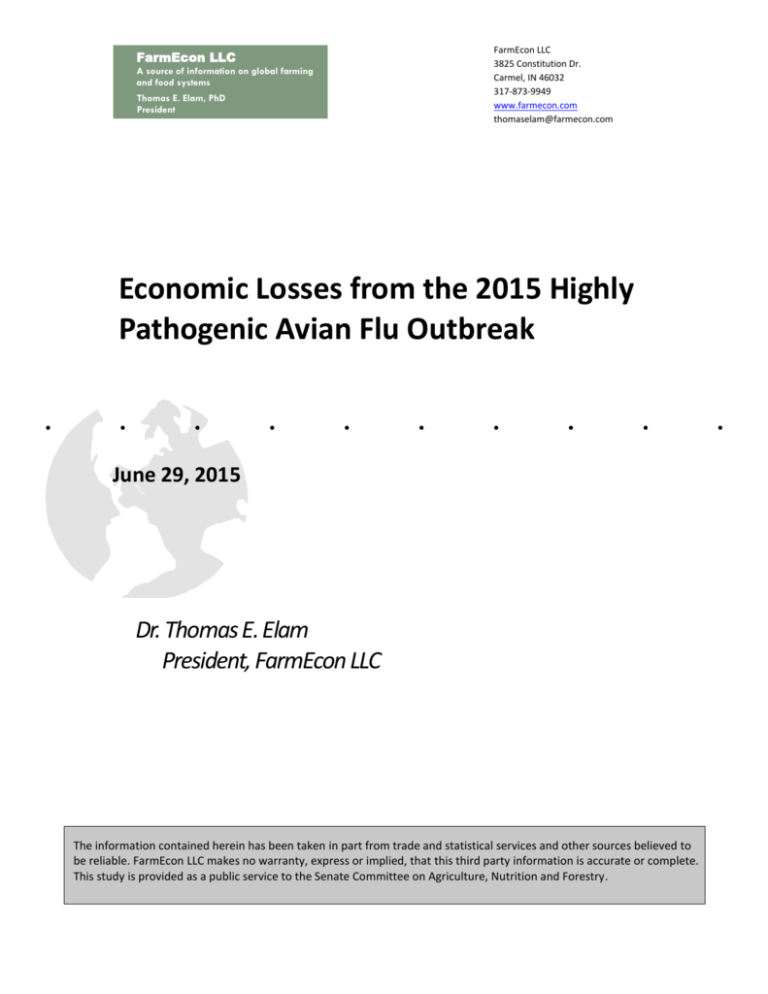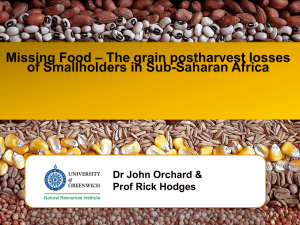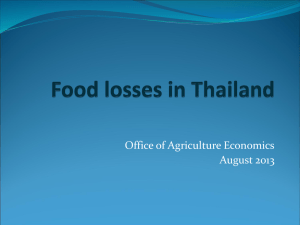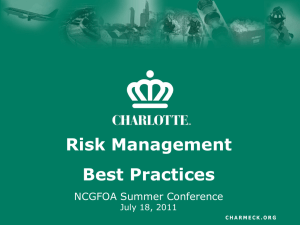HPAI Economic Losses to the Turkey Sector and
advertisement

FarmEcon LLC 3825 Constitution Dr. Carmel, IN 46032 317-873-9949 www.farmecon.com thomaselam@farmecon.com FarmEcon LLC A source of information on global farming and food systems Thomas E. Elam, PhD President Economic Losses from the 2015 Highly Pathogenic Avian Flu Outbreak . . . . . . . . . June 29, 2015 Dr. Thomas E. Elam President, FarmEcon LLC The information contained herein has been taken in part from trade and statistical services and other sources believed to be reliable. FarmEcon LLC makes no warranty, express or implied, that this third party information is accurate or complete. This study is provided as a public service to the Senate Committee on Agriculture, Nutrition and Forestry. . Economic Losses from the 2015 Highly Pathogenic Avian Flu Outbreak Executive Summary This paper contains a preliminary estimate of selected economic losses from the unfolding 2015 Highly Pathogenic Avian Influenza (HPAI) outbreak in the U.S. Losses to both turkey and egg sectors will be included. The estimates are preliminary as of the date of this paper. The outbreak is likely over, with the last report of new layer flock infection confirmed on June 17, 12 days ago. However, further losses cannot be ruled out. It is also preliminary in that there is incomplete knowledge of losses in both the turkey and layer breeding flocks that will significantly affect longer term turkey and egg production. There are also other significant unknowns surrounding the production losses. These include time and costs required to clean and restock affected operations, details on the age of lost flocks, and the potential for future outbreaks later in 2015. All of these unknowns could significantly increase the magnitude of the loss estimates in this paper. Losses included in the paper are also for the value of lost turkey and egg production only. They do not include estimated cleanup costs, or increased costs to consumers from higher egg prices. Losses do include direct production losses to both turkey and egg producers. Those losses are expanded to economy-wide losses, including retail and foodservice, using a method employed in a recent University of Minnesota paper on this subject. Economy-wide losses to date total an estimated $3,289 million spread over the remainder of 2015 and all of 2016. Direct processor losses to date over that same period total an estimated $1,566 million. HPAI Economic Losses to the Turkey Sector and U.S. Economy Actual Turkey Losses Through June 29, 2015: HPAI has, to date, resulted in the loss of approximately 8.0 million market and breeding flock turkeys. One major breeding company has disclosed significant losses in turkey poult (baby turkey) capacity that could reduce total U.S. turkey poult supply by 6.4% from August through December, 2015. The poult loss would affect both 2015 and 2016 turkey production. In this paper it is assumed that the current outbreak’s turkey production loss is an average market live weight of 45 pounds per tom and 16 pounds per hen and light tom. This estimate is also based on an assumption of about 90 days from HPAI detection to re-stocking. If re-stocking takes longer it could increase the loss. If it can be done faster losses may be less. It is assumed that HPAI losses in re-stocked facilities, if any, will be minor. Restocking is proceeding, and we are making good progress. It is also assumed that replacement poults will be available on a timely basis to replace all of the 8.0 million lost turkeys. This could be a major issue as there have also been some losses in the breeding flock, and there will be a bunching effect on poult demand that could delay re-stocking somewhat. Prices assigned to the lost production are pre-loss average prices reported by USDA from January 2014 through the end of March, 2015. The prices used do not reflect significant post-HPAI market price increases that have resulted from the production losses or private contract prices set between processors and customers. The tom price is a weighted average of tom cut-up parts. The hen and light tom overall average price includes 8-16 pound hen and 16-24 pound tom whole bird prices. FarmEcon LLC, June 29, 2015 Page 1 Economic Losses from the 2015 Highly Pathogenic Avian Flu Outbreak Losses at both the turkey and egg the processor level do not include losses that will occur in the marketing chain from processor to final consumer. These losses include the economic activity that will not occur as result of lower volumes of products available for sale. A recent University of Minnesota paper estimated that the ultimate economy-wide loss is about 2.1 times the processor lost value1. Since the Minnesota paper was published production losses have grown to about twice the magnitude estimated by the author. The table below summarizes the estimated losses for HPAI outbreak-related turkey deaths of 8.0 million birds. It does not include the impact of higher prices on consumer spending, further production losses as a result of breeding flock destruction, or any re-stocking delays past the assumed 90 days, and resulting further production losses. Prices used are pre-HPAI, and do not reflect post-HPAI increases. Including value multiplier effects, the total economic loss from the bird losses to date is $632 million. Current Turkey Sector and Economy-Wide Loss Estimates for Bird Losses as of June 29, 2015 Item Live Pounds Lost/Tom Toms Lost, Millions Total Lost Tom Pounds, Millions Processor Value/$Live Pound Total Processor Value, $Millions Estimated Loss 45 4.24 191 $1.29 $247 Live Pounds Lost/Hen and Light Tom Hens and Light Toms Lost, Millions Total Lost Hen and Light Tom Pounds, Millions Processor Value/$Live Pound Total Processor Value, $Millions 16 3.73 60 $0.90 $54 Total Processor Lost Value at 2014/March 2015 Prices, $Millions $301 University of Minnesota Lost Value Multiplier Total Lost Value to U.S. Economy, $Millions 2.1 $632 Estimated Turkey Losses from Breeding Flock Losses: A major turkey breeding company has estimated breeding flock losses that imply a 6.4% reduction in total turkey poult supply from August through the end of 2015. There have also been other losses at other producers, but no specific estimates are available at this time. To the extent that these losses are not included this estimate is conservative. There are also short term measures that can be used to somewhat mitigate breeding flock losses, and these are also not included. Prices used are pre-HPAI, and do not reflect post-HPAI increases. Hen poults have been in seasonal surplus supply, and not used to produce market turkeys, for the past several years. The surplus occurs over the fall and winter when hens are not need to produce holiday whole bird supply. The estimate for surplus hen poults from July through December of this year is about 5.57 million. Of these, 1 Tuck, Brigid. Impact of Poultry and Egg Production Losses and Poultry Processing Losses Due to the Avian Influenza. University of Minnesota Extension Service. May, 2015 FarmEcon LLC, June 29, 2015 Page 2 Economic Losses from the 2015 Highly Pathogenic Avian Flu Outbreak about 4.41 million are needed to replace hen poults that will not be available as a result of this breeding flock loss. That leaves about 1.16 million hen poults that could be fed to heavier weights, and used to replace lost heavy toms. It is assumed that all available hen poults will be used this coming fall and up to the end of the year. However, at market age toms weight about 45 pounds, and at the same age hens weigh only about 25 pounds. Hens also consume about 12% more feed per pound compared to toms. The feed cost loss is relatively minor, and not included in the loss estimates. Overall, the known breeding flock loss results in 196 million pounds of lost tom production. If all surplus hens are used to replace lost heavy tom and hen poults there is an offsetting gain of almost 28 million pounds of live turkey production. Future Poult Supply-Related Turkey Sector and Economy-Wide Loss Estimates through May 2016 Item Pounds of Tom Production, Total Live Weight, Millions Processor Value/$Live Pound Total Processor Value Lost, $Millions Estimated Loss 196 $1.29 $254 Net Gain in Hen Production from Reduced Hen Destruction, Millions Lbs. Processor Value/Pound Total Processor Value Gained, $Millions 27.5 $0.90 $25 Net loss of processor value from breeding stock loss, $Millions $229 University of Minnesota Lost Value Multiplier 2.1 Total Lost Value to U.S. Economy, $Millions $481 At pre-loss market prices the net producer loss is another $229 million. The total economic loss is $481 million. This loss occurs between November 2015 and about May 2016 as the reduced poult supply is raised and marketed. Total Current and Future Loss: Total economic loss for this outbreak is estimated at $530 million direct cost to processors and $1,113 million to the U.S. economy. Total Turkey Sector and Economy-Wide Loss Estimates through May 2016 Item Processor Value Loss from Current Turkey Losses through June 22, 2015 Processor Value Loss from Reduced Poult Supply, August-December 2015 Total Processor Value Loss from 2015 HPAI Outbreak, Millions University of Minnesota Lost Value Multiplier Total Turkey Lost Value to Economy, Millions Estimated Loss $301 $229 $530 2.1 $1,113 These estimates are for lost production only. They do not include the impact of higher retail and restaurant prices that are already resulting from smaller product supplies. Also not included are future losses from the FarmEcon LLC, June 29, 2015 Page 3 Economic Losses from the 2015 Highly Pathogenic Avian Flu Outbreak current outbreak past June 29, 2015, or any future outbreaks later in 2015, 2016, or beyond. Further turkey flock losses could add to the already significant economic losses shown above. HPAI Economic Losses to the Egg Sector and U.S. Economy Loss of 40.2 million lost laying hens and pullets, over 11% of the total flock, is estimated to result in a loss of 959 million dozen eggs between now and the time egg production can fully recover. This is estimated to take up to two years, but during that time production will be steadily increasing once hen re-stocking gets underway. We cannot immediately replace all the lost hens. There are not enough replacements available to do so. Even if there were enough replacements, the bunching effect of so many flocks of the same age would not result in a steady flow of suitably sized eggs. A surge in supply would also be followed by a decline as the replacement flocks of the same age go through a production cycle, resulting in egg surpluses, then shortages, and significant price swings. Neither the egg industry nor consumers would benefit from overproduction followed by shortages. The estimates below assume that each lost hen or pullet results in a year’s loss of average egg production per layer. This loss is spread over the roughly 24 months it will take the sector to restock and recover to full production. For the same reasons that were discussed for turkeys, these losses are preliminary estimates. Prices used are pre-HPAI, and do not reflect substantial post-HPAI increases. Current Egg Sector and Economy-Wide Loss Estimates for Layer Losses as of June 29, 2015 Item Laying Hens and Pullets Lost, Million Dozen Eggs per Lost/Hen and Pullet Total Dozen Eggs Lost, Million Percent Shell Eggs Percent Egg Products Estimated Loss 40.2 23.8 959 36% 64% Shell Eggs Lost, Million Dozen Processor Shell Egg Value/$Dozen Total Processor Shell Egg Value Lost, $Million 348 $1.29 $448 University of Minnesota Lost Value Multiplier Total Economic Loss, $Million 2.1 $941 Breaker Eggs Lost, Million Dozen Processor Breaker Egg Value/Dozen Total Processor Breaker Value Lost, $Million 611 $0.96 $588 University of Minnesota Lost Value Multiplier Total Economic Loss, $Million 2.1 $1,235 Total Egg and Egg Products Processor Value Lost, $Million $1,036 University of Minnesota Lost Value Multiplier Total Economic Loss, Shell and Breaker Eggs, $Million 2.1 $2,176 FarmEcon LLC, June 29, 2015 Page 4 Economic Losses from the 2015 Highly Pathogenic Avian Flu Outbreak Due to heavy Iowa losses, breaking egg production has been disproportionately reduced relative to shell eggs. Breaking egg products are widely required for bakery products, ice cream, confections, and other grocery products. The baking industry has been particularly affected. The estimated $588 million breaker loss is based on an estimated processor market value of breaking egg products. Prices used are pre-HPAI, and do not reflect substantial post-HPAI increases. The total egg producer lost value is conservatively estimated at $1,036 million. The loss to the total economy is conservatively estimated at $2,176 million. The losses in the table above do not include the effects on consumer egg and egg product spending caused by record high egg and egg product prices seen since the HPAI outbreak. Higher egg prices of the magnitude seen in May and June 2015 could result in many times the roughly $2.176 million production loss impact shown in this table. Wholesale table egg prices have more than doubled at their peak since the outbreak, and most egg product prices have tripled. Stated losses also do not include further losses from further hen loss in this or any future outbreaks. Economywide losses also likely do not fully include effects of the approximately 25% loss of the total breaker egg supply. This loss could reduce egg product-dependent production. The effects of such a large loss could be underestimated by the University of Minnesota 2.1 value multiplier. Total HPAI Losses from the Current Outbreak as of June 29, 2015 Known and projected production losses from poultry bird losses through June 29, 2015 conservatively total $1,566 million at the primary processor level. Total loss to the U.S. economy totals $3,289 million. Current Turkey and Egg Sector and Economy-Wide Loss Estimates for Bird Losses as of June 29, 2015 Item Total Turkey and Egg Processor Value Lost from 2015 HPAI Outbreak, $Millions University of Minnesota Lost Value Multiplier Total Turkey and Egg Economic Loss from 2015 HPAI Outbreak, $Millions Estimated Loss $1,566 2.1 $3,289 This is by far the most significant HPAI outbreak in U.S. history, and the economic damage is correspondingly record large. The economic impact shown above underestimates the complete picture. Further bird losses are possible, no impact of higher consumer prices is included, nor in the case of eggs is sufficient value put on potential lost production of food items, especially bakery products, heavily dependent on egg products. Potential Losses from Future HPAI Outbreaks If measures taken to stop the spread of HPAI are not effective future losses can be expected. The wild birds that spread the virus vertically to poultry flocks migrate through heavily populated poultry areas every spring and fall. There is no reason to believe that another H5N2, or other AI strain in general, outbreak is not possible, or if it occurs it will be confined to just the flocks directly infected vertically by wild birds. There also no reason to expect that broiler sector, almost completely bypassed by this outbreak, would escape a future outbreak. If we cannot prevent and better control future outbreaks the security and affordability of our food supply is under significant threat. We should use every measure at our disposal to prevent the spread of HPAI in U.S. poultry flocks. FarmEcon LLC, June 29, 2015 Page 5 Economic Losses from the 2015 Highly Pathogenic Avian Flu Outbreak We can speculate that another HPAI outbreak in the fall of 2015 or spring of 2016 could result in losses at least as large as the current outbreak’s estimated $3.3 billion. If the disease were to spread to the much larger broiler sector losses could be many multiples of those we have already seen in turkeys and layers. Furthermore, if we do not eradicate HPAI we run the very real risk that it could become a chronic, endemic, disease issue in U.S. turkey, broiler and layer flocks. The economic damage of lost production and exports from long term HPAI re-occurrence could be devastating to poultry producers, the food supply, and U.S. consumers. Recommendations Prevention and Eradication: First and foremost, this committee and the Congress should ensure that USDA has sufficient resources to address its dual roles in HPAI outbreaks, namely prevention and eradication. USDA alone has the resources to look at this issue across the entire span of original infection sources (vertical transmission from wild birds) and farm-to-farm (horizontal flock-to-flock) transmission. APHIS has done an incredible job in the current outbreak. However, despite its efforts, and those of producers, the virus was able to spread to a record number of flocks and birds. USDA has a key role to play in discovering how this virus managed to bypass current biosecurity measures. Our only chance of preventing further outbreaks, or if they occur limiting their scope, is to discover what went wrong, and put into place countermeasures to prevent, or at least limit, another occurrence. It will take a public-private partnership to make that happen. If USDA does not have the resources to play its key role, our ability to prevent and control future outbreaks will be severely endangered. The goal should be nothing short of complete eradication. As part of this program we need to consider the role of vaccination as one option. To make vaccination a viable option we would need more effective products than are available at this time. Indemnification Payments: Conservatively estimated economic effects of the record-large HPAI damages contained in this paper are nation-wide. The numbers are large, and meaningful, but do not account for disproportionate impact on affected operations. For those farms and companies with lost flocks the impact is much more severe than the nationwide statistics. Some farms have lost 100% of their turkeys. Some egg producers have lost over 25% of their layers and pullets. The financial impact for these operations is shattering. I have been consulted by several turkey and layer producers on indemnification payment rate issues. Based on those conversations it is apparent that current rates fall short of HPAI’s actual economic damages. The question needs to be asked, “Do current USDA HPAI indemnification payment rates meet the intent of Congress?” It is strongly suggested that Congress hold hearings on the general adequacy of USDA’s HPAI indemnification payments, and specific payment rates that have been applied to this outbreak. At a minimum, affected flock owners, industry experts, and USDA personnel who administer the program need to be involved in those hearings. FarmEcon LLC, June 29, 2015 Page 6








